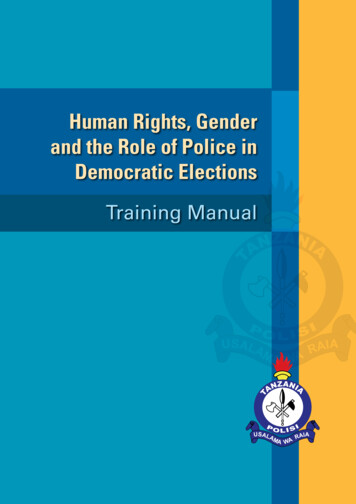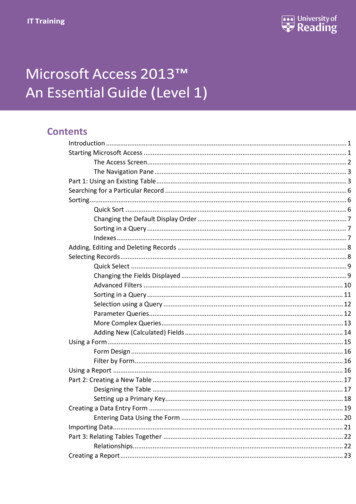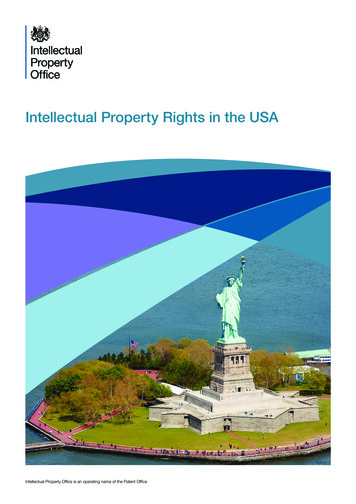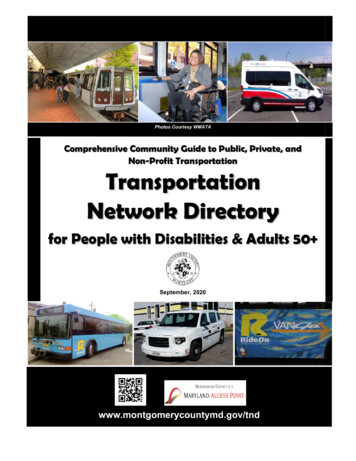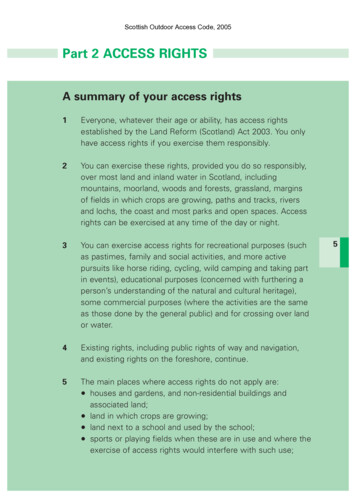
Transcription
Scottish Outdoor Access Code, 2005Part 2 ACCESS RIGHTSA summary of your access rights1Everyone, whatever their age or ability, has access rightsestablished by the Land Reform (Scotland) Act 2003. You onlyhave access rights if you exercise them responsibly.2You can exercise these rights, provided you do so responsibly,over most land and inland water in Scotland, includingmountains, moorland, woods and forests, grassland, marginsof fields in which crops are growing, paths and tracks, riversand lochs, the coast and most parks and open spaces. Accessrights can be exercised at any time of the day or night.3You can exercise access rights for recreational purposes (suchas pastimes, family and social activities, and more activepursuits like horse riding, cycling, wild camping and taking partin events), educational purposes (concerned with furthering aperson’s understanding of the natural and cultural heritage),some commercial purposes (where the activities are the sameas those done by the general public) and for crossing over landor water.4Existing rights, including public rights of way and navigation,and existing rights on the foreshore, continue.5The main places where access rights do not apply are: houses and gardens, and non-residential buildings andassociated land; land in which crops are growing; land next to a school and used by the school; sports or playing fields when these are in use and where theexercise of access rights would interfere with such use;5
Scottish Outdoor Access Code, 2005 land developed and in use for recreation and where the exercise of access rights would interfere with such use;golf courses (but you can cross a golf course provided youdon’t interfere with any games of golf);places like airfields, railways, telecommunication sites,military bases and installations, working quarries andconstruction sites; andvisitor attractions or other places which charge for entry.6Local authorities can formally exempt land from access rightsfor short periods. Local authorities and some other publicbodies can introduce byelaws.7Access rights do not extend to: being on or crossing land for the purpose of doing anythingwhich is an offence, such as theft, breach of the peace,nuisance, poaching, allowing a dog to worry livestock,dropping litter, polluting water or disturbing certain wildbirds, animals and plants; hunting, shooting or fishing; any form of motorised recreation or passage (except bypeople with a disability using a vehicle or vessel adapted fortheir use); anyone responsible for a dog which is not under propercontrol; or to anyone taking away anything from the land for a commercialpurpose.8Statutory access rights do not extend to some places or tosome activities that the public have enjoyed on a customarybasis, often over a long period of time. Such access is notaffected by the Land Reform (Scotland) Act 2003 and willcontinue.6
Scottish Outdoor Access Code, 2005Introduction2.1 The Land Reform (Scotland) Act 2003 establishes access rightsand these must be exercised responsibly. This part of the Codesummarises where and when you can exercise these rightsand for what purposes, and lists those areas where, andactivities to which, access rights do not apply. Understandingthe extent of access rights will help you to exercise themresponsibly.Where and when you can exercise accessrights2.2 Everyone, whatever their age or ability, can exercise accessrights over most land and inland water in Scotland, at any timeof day or night, providing they do so responsibly2. These rightsdo not extend to all places or to all activities (see paragraphs2.11 to 2.15). Provided you do so responsibly (see Parts 3 and5 of the Code), you can exercise access rights in places suchas: hills, mountains and moorland; woods and forests; most urban parks, country parks and other managed openspaces; rivers, lochs, canals and reservoirs; riverbanks, loch shores, beaches and the coastline; land in which crops have not been sown; on the margins of fields3 where crops are growing or havebeen sown;23Sections 1 and 2, Land Reform (Scotland) Act 2003Section 7(10) of the Land Reform (Scotland) Act 2003 states land on whichcrops are growing does not include “headrigs, endrigs or other margins offields in which crops are growing”.7
Scottish Outdoor Access Code, 2005 grassland, including grass being grown for hay or silage(except when it is at such a late stage of growth that it islikely to be damaged); fields where there are horses, cattle and other farm animals; on all core paths agreed by the local authority4; on all other paths and tracks where these cross land onwhich access rights can be exercised; on grass sports or playing fields, when not in use, and onland or inland water developed or set out for a recreationalpurpose, unless the exercise of access rights wouldinterfere with the carrying on of that recreational use; golf courses, but only for crossing them and providing thatyou do not take access across greens or interfere with anygames of golf; on, through or over bridges, tunnels, causeways, launching8sites, groynes, weirs, boulder weirs, embankments of canalsand similar waterways, fences, walls or anything designedto facilitate access (such as gates or stiles).2.3 You can also exercise access rights above5 or below the land(for example, you can exercise access rights in the air and incaves). Access rights apply under water as well as on thesurface.2.4 You can exercise access rights at any time of the day or night,provided you do so responsibly. The Code provides specificguidance on responsible access at night (see paragraphs 3.19and 3.20).45Local authorities must produce, within three years of the legislation cominginto force, core path plans setting out their proposals for a system of paths –called “core paths” – sufficient for the purpose of giving the public reasonableaccess throughout their areas.Subject to any regulations governing the use of air space in any particularplace.
Scottish Outdoor Access Code, 20052.5 Access rights do not apply on some types of land and theseare described in paragraph 2.11. Where some landmanagement operations are taking place, such as cropspraying or tree felling and harvesting, you might be asked toavoid using particular routes or areas for your own safety (seeparagraphs 3.24 to 3.28). In some places, local authorities andsome other public bodies may have introduced byelaws orother statutory regulations which might affect how you canexercise access rights (see paragraph 2.11).What you can do under access rights2.6 You can exercise access rights for recreational purposes, someeducational activities and certain commercial purposes, and forcrossing over land and water.2.7 “Recreational purposes” is not defined in the legislation. It istaken to include: pastimes, such as watching wildlife, sightseeing, painting,photography and enjoying historic sites; family and social activities, such as short walks, dogwalking, picnics, playing, sledging, paddling or flying a kite; active pursuits, such as walking, cycling, horse riding andcarriage driving, rock climbing, hill-walking, running,orienteering, ski touring, ski mountaineering, caving,canoeing, swimming, rowing, windsurfing, sailing, diving, airsports and wild camping; and participation in events, such as walking or cyclingfestivals, hill running races, mountain marathons, mountainbiking competitions, long-distance riding events, orienteeringevents and canoeing competitions.2.8 Access rights extend to any educational activities concernedwith furthering a person’s understanding of the natural or9
Scottish Outdoor Access Code, 2005cultural heritage6. For example, access rights would extend tothe students, leader and any support staff on a visit to theoutdoors to learn about wildlife or landscapes or geologicalfeatures. People carrying out field surveys of the natural orcultural heritage, such as of birds or plants, as a recreationalactivity or for educational purposes, are covered by accessrights (see paragraph 3.64).102.9 Access rights extend to activities carried out commercially orfor profit, provided that these activities could also be carried onother than commercially or for profit (ie by the general publicfor recreational purposes or for educational activities or forcrossing land). For example, a mountain guide who is taking acustomer out hill-walking is carrying on a commercial activitybut this falls within access rights because the activity involved– hill-walking – could be done by anyone else exercising accessrights. The same would apply to a canoe instructor from acommercial outdoor pursuits centre with a party of canoeists.Other examples would be a commercial writer or photographerwriting about or taking photographs of the natural or culturalheritage.2.10 Access rights can also be used to cross land and inland water.This means going into land or inland water, passing over it andthen leaving it for the purpose of getting from one place toanother place, and is not limited to recreational purposes oreducational activities. Access rights for recreational purposes,for relevant educational activities and for relevant commercialpurposes refer to going into, passing over and remaining onland or inland water for these purposes and then leaving it.6Section 1, Land Reform (Scotland) Act 2003. Natural heritage is defined asincluding the flora and fauna of the land, its geological and physiographicalfeatures and its natural beauty and amenity. Cultural heritage is defined asincluding structures and other remains resulting from human activity of allperiods, traditions, ways of life and the historic, artistic and literaryassociations of people, places and landscapes.
Scottish Outdoor Access Code, 2005Where do access rights not apply?2.11 Access rights do not apply in the following places7. Land on which there is a house, caravan, tent or other placeaffording a person privacy or shelter, and sufficient adjacentland to enable those living there to have reasonablemeasures of privacy and to ensure that their enjoyment ofthe house or place is not unreasonably disturbed. The extentof this land may depend on the location and characteristicsof the house (see paragraphs 3.13 to 3.17). Gardens which are separated from houses but onlyaccessible to the residents who have common rights inthem (these are usually found in cities such as Edinburghand Glasgow). Land on which there is a building or other structure orworks, plant or fixed machinery, and land which forms thecurtilage of a building or which forms a compound or otherenclosure containing any structure, works, plant or fixedmachinery. Examples of non-residential buildings andstructures include: farm buildings and yards; animal and birdrearing pens; sports centres, pavilions and stands; clubhouses; factories; warehouses and storage areas; militarybases and other installations; pipelines; chemical and otherprocessing plants; canal locks and lifts; water treatment andsewage works; horticultural nurseries; and, fish farms andhatcheries. Land in which crops have been sown or are growing8. Cropsare taken to include cereals (such as wheat and barley),vegetables (such as potatoes, turnips and cabbages), fruits78Sections 6 and 7, Land Reform (Scotland) Act 2003However, you can exercise statutory access rights on the margins of fields,along paths and tracks, and on any unsown ground (see paragraphs 2.2 and3.35 to 3.37).11
Scottish Outdoor Access Code, 2005(such as strawberries and raspberries). Grass being grownfor hay or silage and which is at such a late stage of growththat it is likely to be damaged by you exercising accessrights is a crop (see paragraph 3.37). Grass sports pitches or playing fields whilst they are in usefor their intended purpose (for example, you cannot exerciseyour access rights on a grass football field whilst there is afootball match in progress). Any sports pitch or playing field with an artificial surface(such as synthetic grass or rubber), whether or not in use. On golf greens, bowling greens, cricket squares, lawn tenniscourts or other similar area on which grass is grown andprepared for a particular recreational purpose, whether ornot in use.12 Land or water that has been developed or set out for arecreational purpose, whilst in use and where your exerciseof access rights would interfere with the recreational useintended for that land, such as horse racing gallops9. On land contiguous to any school and used by that school(such as a playing field). Places where you have to pay to go in10, such as castles,historic houses and gardens, historic sites, and visitorattractions.9Section 7 (8) of the Land Reform (Scotland) Act 2003 states that this does notinclude land on which groynes have been constructed, deepening of poolshas been undertaken, fishing platforms have been erected or where otherworks for the purposes of fishing have taken place. Access rights cantherefore be exercised in these places.10 Section 6 (1)(f) of the Land Reform (Scotland) Act 2003 states that these areplaces where the public were admitted only on payment on at least 90 days inthe year to 31 January 2001 and on at least 90 days in each year thereafter.
Scottish Outdoor Access Code, 2005 Building, civil engineering or demolition sites. Railway and airfield infrastructure and airports. Working quarries and other surface workings. Land or water where public access is, by or under any otherlegislation, prohibited, excluded or restricted. This wouldnormally be for safety grounds or public security reasons11.In some places, byelaws, management rules or otherregulations may have been introduced by a local authority orother similar public body and these may affect how you canexercise access rights. All byelaws need to be consistentwith the access provisions in the Land Reform (Scotland)Act 200312. Land exempted from access rights through an order madeby a local authority (for exemptions lasting for six or moredays, the order needs to be confirmed by Ministers and besubject to public consultation)13.11 For example, military bases and other installations. On other land or watermanaged by the Ministry of Defence there is usually a presumption in favourof recreational access wherever this is compatible with the primary militarypurpose. Follow any local information on access to such land. See Part 5 forfurther information.12 Local authorities and some other public bodies (see paragraph 6.7) canintroduce byelaws. Section 30, Land Reform (Scotland) Act 2003 states thatall byelaws must be reviewed and, if necessary, modified by the appropriatelocal authority or public body so that they are consistent with the provisions inthe Act. This must be done within two years of the Act coming into force.13 Section 11, Land Reform (Scotland) Act 2003. This power might need to beused for some sporting events, such as motorised hill trials, car rallies andwater skiing competitions, and some other events, such as agriculturalshows, car boot sales, music festivals, wedding receptions and eventsinvolving the sale of goods or catering.13
Scottish Outdoor Access Code, 2005What activities are excluded from accessrights?2.12 Access rights must be exercised in ways that are lawful andreasonable. By definition this excludes any unlawful or criminalactivity from the time at which it occurs. Furthermore, beingon or crossing land for the purpose of doing anything which isan offence or a breach of an interdict or other order of a courtis excluded from access rights. This means that a personintent on such a purpose is excluded from access rights at thetime they seek to enter the land. This is also taken to includethe carrying of any firearm, except where the person iscrossing land or water to immediately access land or water, orreturn from such, where shooting rights are granted, held orheld in trust or by any person authorised to exercise suchrights.142.13 A list of the more obvious statutory offences relating topeople’s behaviour is provided at Annex 1. This list includespoaching, vandalism, not clearing up after your dog has fouledin a public place, being responsible for a dog worryinglivestock, dropping litter, polluting water, and disturbing wildbirds, animals and plants. There are also common lawoffences, such as breach of the peace.2.14 The Land Reform (Scotland) Act 2003 excludes some otherconduct from access rights14, including: Hunting, shooting or fishing. These activities still require thepermission of the relevant owner. Motorised activities, such as motor biking and scrambling,off-road driving, the use of any powered craft on water,microlighting, and the use of powered model craft. Theseactivities still require the permission of the relevant owner ormanager. Access rights, however, do extend to a person14 Section 9, Land Reform (Scotland) Act 2003
Scottish Outdoor Access Code, 2005with a disability who is using a motorised vehicle or vesselbuilt or adapted for use by that person15. Being on or crossing land while responsible for a dog that isnot under proper control (see paragraph 3.55). Being on or crossing land or water for the purpose of takingaway, for commercial purposes or for profit, anything in oron the land or water (for example, mushrooms or berriespicked for commercial use, or gravel and stones).What about public rights of way andnavigation?2.15 Public rights of way are different from access rights and havebeen recognised in Scots law for centuries and are a valuablepart of our cultural heritage. For a right of way to beestablished under the common law, it must run from onepublic place to another public place along a more or lessdefined route (it need not be an identifiable path), and it musthave been used openly and peaceably by the public, otherwisethan with the permission, express or implied, of the landowner,for at least 20 years. Many rights of way have beenestablished for walkers only, but some have been establishedfor use by horse riders and cyclists, and a small number existfor motorised vehicular use.2.16 All public rights of way will continue to exist16 and areunaffected by the Land Reform (Scotland) Act 200317. You canexercise access rights over public rights of way where theseroutes pass over the land listed in paragraph 2.2. Where apublic right of way passes over land excluded from accessrights, such as the land associated with a building or land onwhich crops are growing, you can still use the route as a right15 Subject to the Highway Code being adhered to.16 Information on rights of way is available from local authorities. Also seewww.outdooraccess-scotland.com for links to other appropriate bodies.17 Section 5, Land Reform (Scotland) Act 200315
Scottish Outdoor Access Code, 2005of way. Although access rights do not extend to the use ofmotorised vehicles, you can still use a vehicular right of waywhere it has been established.2.17 Existing public rights of navigation will continue on navigablelochs and rivers.What about public rights on the foreshore?2.18 Public rights on the foreshore18 and in tidal waters will continueto exist. These have not been fully defined but includeshooting wildfowl, fishing for sea fish, gathering someuncultivated shellfish, lighting fires, swimming, playing on thesand and picnicking. Access rights also extend to these places.16What about activities and places not coveredby access rights?2.19 Provided you exercise them responsibly, access rightsestablished by the Land Reform (Scotland) Act 2003 arewide-ranging in terms of the places and activities that theyextend to. Nonetheless, access rights do not apply to someplaces where the public have enjoyed access perhaps over along period of time. Examples include passing through somefarmyards and across some dams. Certain activities that arenot included in statutory access rights have also beenpracticed for a long time by the public, such as gatheringnatural berries or fruit for personal use or sledging on somegolf courses. Such access and activities are not affected by theLand Reform (Scotland) Act 2003.18 The foreshore is the land between the upper and lower ordinary spring tides.
rights can be exercised at any time of the day or night. 3 You can exercise access rights for recreational purposes (such as pastimes, family and social activities, and more active pursuits lik



